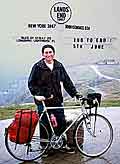
Day 1 (5 June)
Land's End
This sun-blocker is certainly effective. I put it on, and immediately, it clouds over and it rains for three weeks.
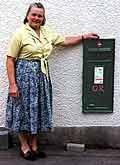
Day 5 (9 June)
Moorlynch, Somerset
Cycle past England's only green post box. It's part of a village store where the marvellously obstinate lady owner keeps repainting it green to match the shop the day after the Post Office repaint it red. Still raining.
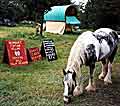
Day 8 (12 June)
Middle England
Stop at gypsy caravan for fortune telling. She looks at my bike, panniers and maps, and says 'You are going on a long journey'. She must have The Gift.
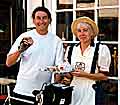
Day 9 (13 June)
Melton Mowbray
Dickinson & Morris, the Rolls-Royce of the pork pie world, give me VIP treatment when they hear of my trip. And free pork pie. Top place.
Day 9 (13 June)
Somerby, Leics
Afternoon misspent at The Old Brewery pub, where they brew their own fantastic beer: Baz's Bonce Blower works better than morphine for inducing euphoria and soothing sore arse. Barry Parish, landlord and brewer, gives me free pint when I tell him of my trip. Top pub, top bloke.

Day 9 (13 June)
Leics/Rutland border
Curious signpost two miles from The Old Brewery: it appears to point to PISSWELL. Gawp at it in puzzlement, first thinking Baz's Bonce Blower implicated in altered perceptive state. Realise with relief that someone has been at work with screwdriver switching letters.

Day 13 (17 June)
N York Moors
Rain has evidently turned phone boxes green. Or perhaps they paint them this colour to camouflage them from cyclists. Find particularly interesting fungus by roadside. And several in my shoes.
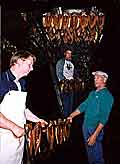
Day 15 (19 June)
Craster, Northumberland
See kippers being smoked. I have friends back home in Bath who've smoked all sorts of things, but never kippers.

Day 15 (19 June)
Scottish border
Road blocked by flock of sheep. Distressed to find they move faster than me.

Day 16 (20 June)
Lammermuir Hills, S of Edinburgh
Donizetti's opera Lucia di Lammermoor was set here, with its famous Mad Scene. After cycling up them, I understand why.

Day 20 (24 June)
S of Helmsdale, on A9
Sunburn takes over from trench-foot as major health threat, but only for two hours.
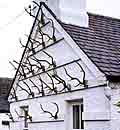
Day 21 (25 June)
Berriedale, on A9
See house which has one wall covered in trophy antlers. Coathooks obviously unobtainable in rural Scotland and natives have to improvise.

Day 21 (25 June)
Berriedale, on A9
Visit llama farm. Apparently they quite like the climate here. Obviously it must be drizzly, grey and cold in the summer over in Peru too.
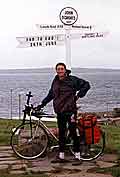
Day 21 (25 June)
John O'Groats
Finished! A bunch of middle-aged walkers, just setting off, all cheer me in. Embarrassingly, I burst into tears. Fortunately, it's raining so hard, they don't notice.
Footnote: June 1997 turned out to have been the wettest for 136 years.
Rob Ainsley tells you everything you need to know about the ultimate British cycle ride: Land's End to John O'Groats
This article originally published in the UK's best monthly cycling monthly magazine, Cycling Plus, in 1998, but with additions, updates, more pictures, and added captions
Most people cycle Land's End to John O'Groats in seven to 14 days. The world record is 41 hours - yes, 41 hours - by the legendary Andy Wilkinson in the same year I did mine, 1997. Except that I was taking three weeks. You can see where I'd finish in the Tour de France. But everyone I met en route said they wished they'd taken longer, to explore the country they were hurtling through. (Funnily enough, everyone I met also said they were "a mate of Andy Wilkinson". Where does he have his birthday parties? Wembley Stadium?)
Yes. Three weeks - if you can swing it with work and family - is the ideal time. Short enough to feel like one trip; but long enough to go by minor roads, take days off, to explore, to chat, to get bike repairs, and to take advantage of any free beers by investing in several more. And to take a route that suits you.
But the arriving at John O'Groat's is the best bit, by miles. 874 miles, in fact. The feeling of elation when you see the Orkneys appear over the horizon, on that final gentle descent to John O'Groats, is something you'll remember for the rest of your life. And probably tell people about at great length in pubs and at dinner parties.
You'll deserve all their admiration and sneaking jealousy, because it's still a hell of an achievement. Around 4,000 cyclists do the End to End every year; that's fewer people than get books published, release a rock album, or get a first-class honours degree.
And there's nothing to stop you. You don't need to be superbly fit, rich or pioneering. The most difficult part is simply booking that slot in your diary now, and arguing it out with work and family later. No-one's ever regretted doing it, but lots of people regret not doing it.
Supported is more difficult to organise beforehand - vans don't come free, you'll owe the driver favours forever, and there's an extra person to fit into B&Bs - but makes the cycling itself much easier. Travel to and from Land's End and John O'Groat's is also much easier.
Unsupported means you don't have to worry about anyone else before or during the trip; you go when you want and do as you please. But panniers double their weight in a headwind and treble up Devon's hills - you absolutely have to travel light.
Which way to go? The Cyclists' Touring Club suggest three routes - main roads, scenic, Youth Hostels - and can supply details along with some accommodation information. Their information pack costs �17.50 or is free if you're a member (�25 per year, with lots of other benefits of course). It's very good if you want the thinking done for you; each is around 1000 miles. The CTC also do a certificate for �5.
Simon Brown's End to End book also suggests a route. Like the CTC's, it follows the basic line of Bristol-Welsh border-Carlisle, then either Glasgow or Edinburgh to Inverness, then Wick or Thurso to John O'Groats. Upwards is the usual way to go, as the prevailing winds tend to come from the south-west, but there's not much in it. If you really want to go top to bottom, do it.
Alternatively, you could go with an organised trip such as those run by Bike Events. For a few hundred quid you have all luggage transported for you, accomm arranged (camp sites) and the atmosphere is very social.
But it's most fun to work out your own route, especially if you theme your trip. Route-planning is great fun, best done by the fire on a cold dark night with a glass of something inspiring. Link up friends and family; or be more inventive. I did local food and drink (Cornish pasties, Bath buns, Lincolnshire haslet, Yorkshire pud, Craster kippers, Edinburgh shortbread). Other cyclists have done the cathedrals (Wells, Coventry, Lincoln, York, Durham). One chap I heard of drank or stayed only at pubs called the Red Lion, and still managed nightly pub-crawls.
The choice is yours. Just avoid those A roads as much as possible. (Between Land's End and Edinburgh I did less than 20 miles on A roads.)
But going by train with a bike in Scotland is a headache - one as big as ScotRail's cycle spaces aren't. Trains from Inverness to Edinburgh or Glasgow can only carry one bike at a time. Couples have to split up. Amazing but true. And you have to book in advance. If you don't, you could have an unplanned overnight stay on your hands. So book now. Apex fares are the cheapest bet, but you'll still spend well over �100 on trains.
When's the best time? There's little point selecting a time to 'guarantee good weather'. Even in June you might never see the sun. (I know from experience.) August is tourist season, which means B&Bs and hostels will be squeezed, so that's best avoided if you can. May to July is the best time from the point of view of having lots of daylight - up till 10 o'clock and even later in Scotland - so that you can sit out that rainstorm, or postpone the cycling till after dinner.
Training? Forget it! We're talking leisurely End to Ends here, not time trialling - not Chris Boardman so much as Stan Boardman. If you can make it to work, you can make it to John O'Groats in three weeks. The thousand miles works out at less than 50 miles a day. Averaging a stately 10mph, that's only five hours' pedalling. (Keen cyclists would average almost double that.)
OK, do a few weekend trips if you're really out of practice, but with time to dawdle, you can easily get fit as you go.
Given Britain's notoriously unreliable weather, you may prefer the safety of the Bed & Breakfast. Out of the school holidays you will have no problems finding a B&B, wherever you end up each evening. If there's no Tourist Info open (or displaying a list of accommodation) then ask in a pub, or keep your eyes open on the road into town. In high season, a place that's full will usually recommend another, even phone round for you. The I'm-End-to-Ending-for-charity routine works wonders. Tourist Infos in some towns like Edinburgh and Pitlochry rush you a few quid just to book accomm. Some places are free (hooray for Durham).
If you get fed up of inner-tube B&B sausages, drying your socks on the radiator and want to save money, go for Youth Hostels; use the drying room, and buy your own cereal. There are just enough Youth Hostels to work into your route, though if they're full the next one will be too far to go tonight. At around �8-�12 a night without breakfast they don't work out that much cheaper than B&Bs (which are �18-�25, typically, and give you that privacy and a colour telly). Phone ahead; hostels will either be nearly empty, or block-booked full of French kids.
Of course, you'll have your address book listing every friend and relative en route, and they will pretend to be delighted when you take up their mumbled offer to stay.
a) Enough tools to twiddle things and mend a puncture, with a couple of spare inner tubes;
That's it. Anything else you can buy on the way if you have to - and in a dire emergency you won't be more than 20 miles from a bike hire shop. Better spend a few quid than abandon the trip.
As for maps, OS Landrangers are wonderful, but with 40 taken to cover the CTC route, it's out of the question for unsupported trips (and would set you back nearly two hundred quid). A bog-standard two-quid road atlas from a remaindered bookshop will do fine: you can tear out pages and fold them up into your map pocket, and chuck finished pages out as you go.
England is hilly, usually in an annoying pointless way. But if you have to get off and push, well, that's a good way of avoiding saddle soreness. The long slow grinds (Shap Fell, the A9 out of Pitlochry) are worst. Except for those rolling hills which are worse still. (Millook Haven in Cornwall has a 30% gradient either side, to steep to cycle down, and certainly too steep to cycle up.)
You'll also get fed up of lying road signs. You know the sort of thing. It says Padstow 5; you cycle two miles up a hill; the next sign still says Padstow four and three-quarters.
But don't worry. With more than two weeks to hand and a bike with more than 10 gears, it's more an exercise in patience (and money) than fitness. The route becomes a succession of rewards: a drink of water at the top of the hill; a cream tea at the next town; a pint or two in the evening. In Britain, even in the moors of Devon or the emptiness of Scotland, you're never far from any of those.
So if you haven't done it, write some dates in big biro in your diary right now and do it. When you get back your friends will still be sitting in the same pubs moaning that there's nothing on telly, and you'll have done something very special. You will always treasure that last mile and will cherish every day of the trip.
Why do it? Whoever said it is better to travel hopefully than to arrive never did the End to End. Of course the travelling is great: you get to see this quirky, gentle patchwork of a country and its people in an intimate way that's impossible from a train or car. And when people find out you're cycling, things happen. You get talking; people buy you drinks, and give you free things from their shops; closed museums open; people invite you in to their houses; scowling officials smile and give two quid to your charity. You feel like a star. (I got free beer, free pork pies and free cycle accessories in Melton Mowbray, under circumstances too bizarre to detail here.)
There are two basic ways to travel: supported, with a friend driving a van full of your luggage and spares, or unsupported, where you carry everything.
Railways can get you there and back. Penzance is the nearest rail station to Land's End, a reasonably hilly ten miles or so away. Land's End is a big naff theme park; cars pay to get in but you don't have to. There's a finger post where they'll put up a customised signpost and take your picture for �5, and a museum where you can see exploits of other end-to-enders. John O'Groats is little more than a cluster of souvenir shops and a hotel or two, plus another finger post photo stop. The nearest stations are each 20 or so miles away, at Thurso and Wick.
England is an expensive place to stay. Camping is fun, relatively cheap and flexible. And wet, and heavy. The Saunders Spacepacker is the best tent for cyclists (sleeps two in comfort and weighs 1.7 kilos, less than a four-pack of beer). Light as that is, it can be a pain to lug around the other stuff that goes with the outdoor life (sleeping bag, stove, wine rack etc.) especially if you're by yourself. And the prices - around �5 or more per person for a campsite - will seem crippling compared to the continent, and there is little chance to wild-camp in England.
Travel light, and I mean hundred-watt light. If you're B&Bing and have filled more than two panniers, it's too much. Start again. All you need, in order of importance, is as follows.
b) One set of waterproof everything;
c) A couple of sets of clothes and handwash;
d) Maps;
e) A compact camera;
f) A very full wallet.
Whenever you go, it'll be the rainiest month since 1864. The wind will make you wish you'd gone the other way, whichever way you go. And a lorry will try to run you off the A30.
Train info, tickets
End to End Biking records
NB The above list, on the Road Records Association's website, doesn't include Andy Wilkinson's 41-hour run in 1997 as this was done on a faired Windcheetah trike. Gethin Butler's 44-hr run of 29 Sep 2001 is the new 'standard' bike record, beating Andy's 45-hr effort in 1990.